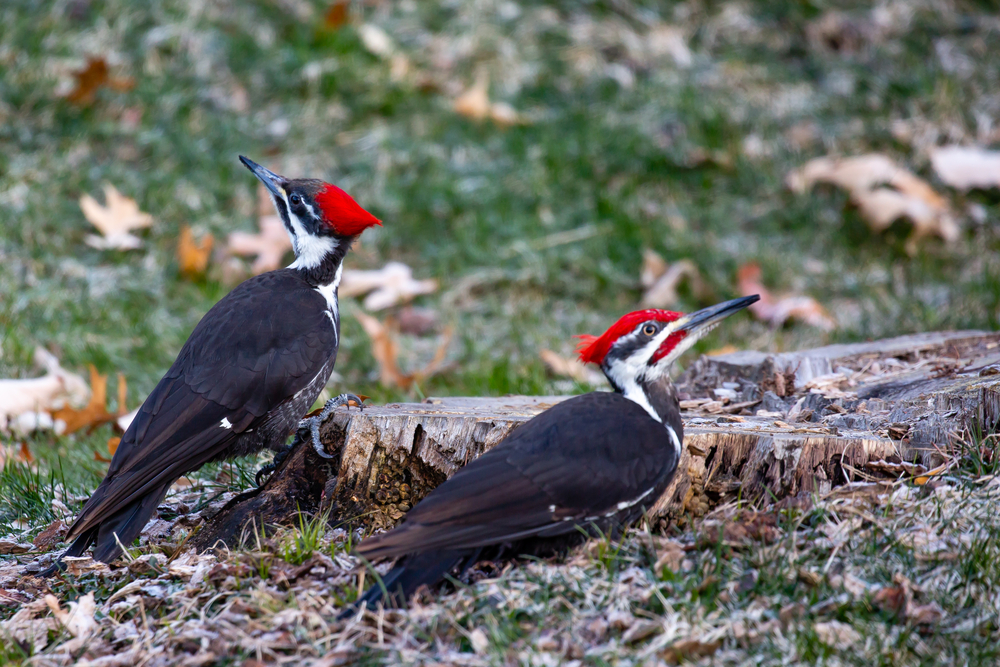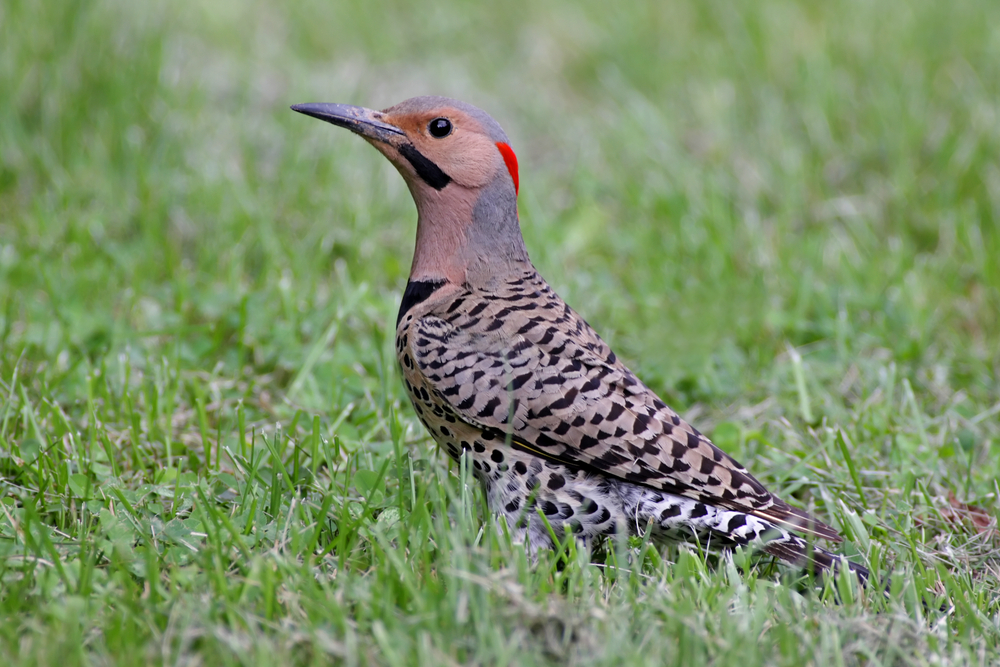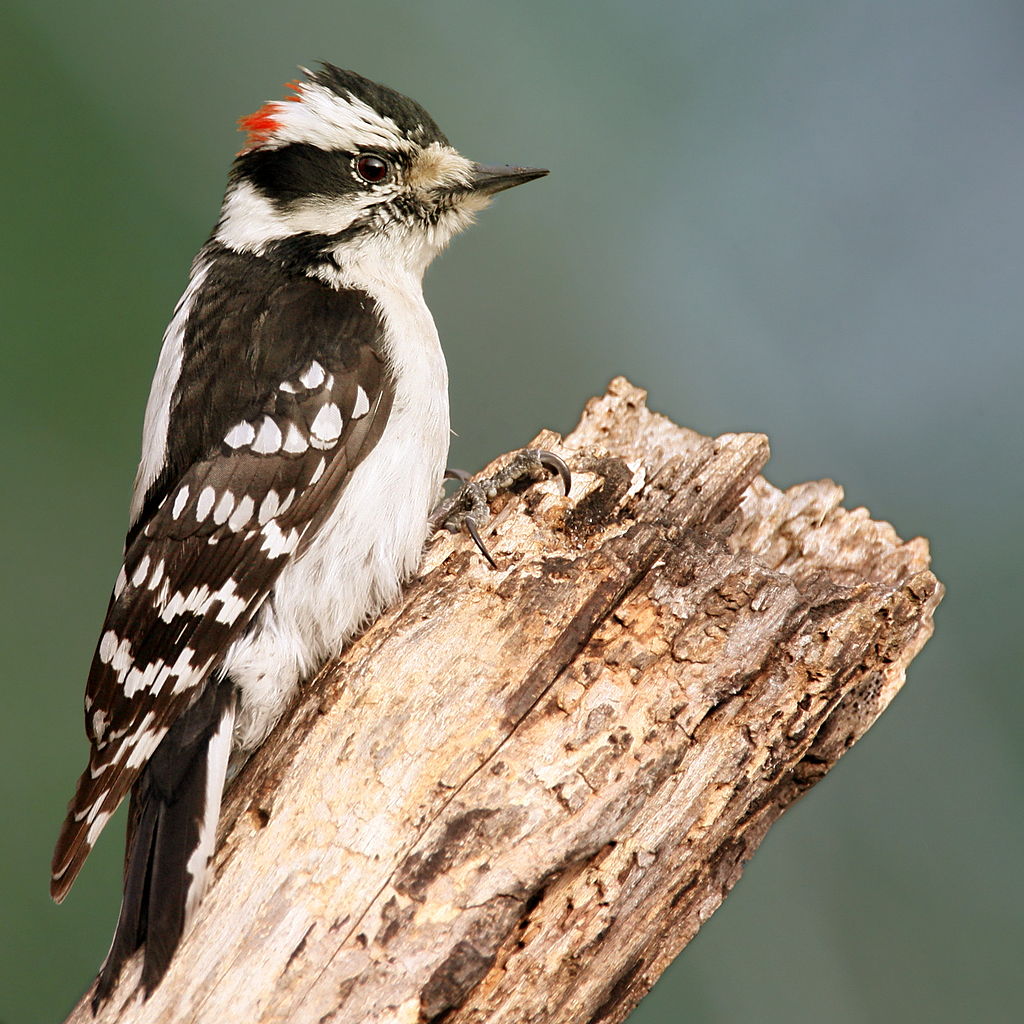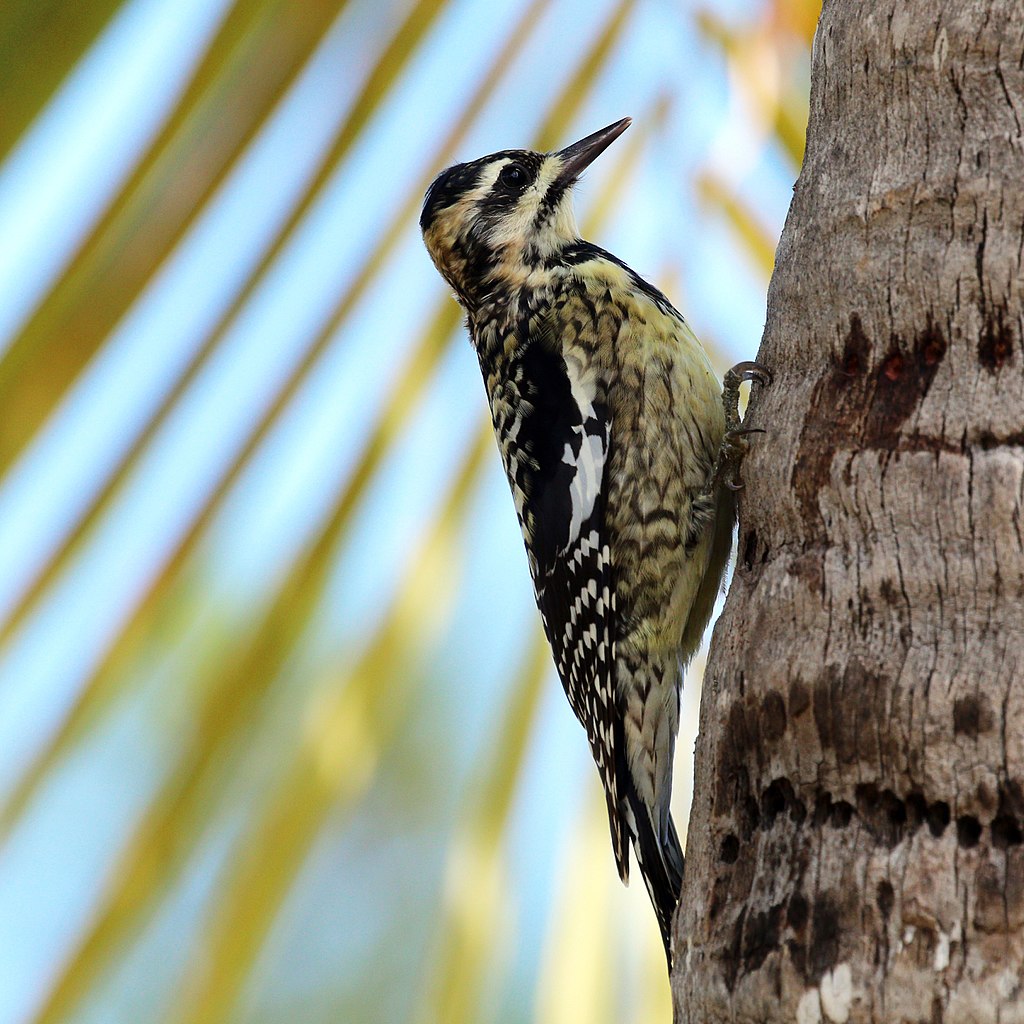Woodpeckers are fun to find when you’re out birdwatching. They are intense, industrious birds, so focused on hollowing out cavities in trees or foraging for insects that they generally pay no mind if you watch them work. Although they live among songbirds, there are lots of adaptations that set them apart from the likes of robins, warblers and the other singing birds.
For one thing, they don’t sing. They drum. While they do have species-specific calls, a lot of woodpecker communication and territory defense is done through drumming, mostly on trees, but often on metal signs, fence posts or on the side of a house.
You would think all that drumming would wear down their bills, or at least leave them with splitting headaches. But nature has provided woodpeckers with lots of protection from the work that they do. For one thing, they have extra strong neck-muscles and a shock-absorbed brain, tightly insulated against the effects of drumming up to 20 beats per second, or up to 12,000 beats per day.
They also have bristle-like feathers over their noses and translucent third eyelids to protect them from exposure to the very sawdust they create. As they hammer away, their bills continually grow new cells to regenerate and stay sharp.
While you may see a woodpecker perched on the branch of a tree, you’re more likely to see one hopping up and down that tree in a way that only a few songbirds like nuthatches and creepers are capable of doing. While songbirds have three forward-facing toes and one backward-facing toe, woodpeckers have two that face forward and two that face back. Between that and their stiff tail feathers, they can brace themselves against the side of a tree, or in the case of some species, grab the bottom of a backyard birdfeeder.
Types of Woodpeckers in Ohio
The 7 woodpeckers that you can meet in Ohio vary greatly, from a bird as big as a crow to one as small as a sparrow, from migrants to year-round residents. But all of them are fascinating to observe if you learn what to look for and listen for when identifying each species. For each of the woodpeckers on our list, we’ve included an Ohio birding hotspot where you can see and hear them in their natural habitat.
Pileated Woodpecker (Dryocopus pileatus)

The Pileated is Ohio’s largest woodpecker by far, and one of the most striking birds you’ll ever come across in the wild. Everything about it is big, from its dagger of a bill to its almost 30-inch wingspan to the flaming red crown that it’s named for. (“Pileated” means “crested”).
Its drumming on decayed and dying trees can be heard from a football field away on a quiet morning. It doesn’t laugh like Woody Woodpecker, the cartoon character that it inspired, but even its call, a maniacal “Wuk! Wuk! Wuk! Wuk!” is louder than any of its bird neighbors.
Pileated woodpeckers are unmistakably unique in appearance, but there is a key field mark used to distinguish between a male and a female, one that’s a common difference between woodpecker genders. While both sexes of the Pileated have a black stripe across the eyes and a second stripe extending from the bill and hooking down to the throat, that second stripe on the female is all black, while the male has a partially red stripe that looks like a moustache, a feature referred to in ornithology as a malar.
Historically, human development has not been kind to the Pileated Woodpecker. Clearing of forests for farms and towns destroyed much of its habitat, and during the time of the Westward Expansion it was even hunted for food. But as abandoned farms reverted back to forests, the Pileated began to repopulate them. These birds have been known to visit backyard bird feeders, but only when those feeders are within range of their otherwise wild habitat. Although they are not as common as some of the other woodpeckers you’ll meet here, but they can still be found in many protected areas around Ohio.
- Length: 15.8” – 19.3” / Wingspan 26” – 29.5”
- Ohio Status: Year-round population; Uncommon due to loss of habitat
- Birding Hotspot: Buck Creek State Park, Clark County
Red-headed Woodpecker (Melanerpes eryrthocephalus)

The Red-headed Woodpecker is another flashy member of the family Picidae that can’t be confused with any other bird. Among its nicknames is the “flying checkerboard”, so named for the bold black and white pattern on its stocky body, which contrasts with a head the color of burgundy wine and a bill like a compact steel sword.
The Red-headed is one of the few species of woodpeckers that are sexually monomorphic, so there is no way for us to distinguish between a male and female. Its call is a sharp, very loud “Churr!” and its drum is a quick roll of 19-25 beats per second, often repeated two or three times. They are also one of the few woodpecker species that stores food, mostly in trees but sometimes under roof shingles.
Scientists have noted sharp fluctuations in historical populations of Red-headed Woodpeckers, often connected to the availability of its food sources. Even though the birds are omnivorous, they seem to be adversely affected by declines of certain tree and insect species. They are currently considered near threatened in much of the U.S. and Canada. While they migrate locally, Ohio is in their year-round territory, and like the Pileated Woodpecker, they can be found in parks, preserves and wildlife refuges around the state.
- Length: 7.5” – 9.1” / Wingspan: 16.5”
- Ohio Status: Near threatened; breeding and locally migrating populations
- Birding Hotspot: Headlands Beach State Park, Lake County
Red-bellied Woodpecker (Melanerpes carolinus)

When it comes to bird identification, sometimes, as in the case of the Red-headed Woodpecker, the bird’s name can help you out. In the case of the Red-bellied Woodpecker, its name is really of no use at all when it comes to making an identification. Yes, there is a slight, pale red tint on its otherwise white belly, but its barely perceptible. Plus most times when you see the bird, it will be “walking” up or down the trunk of a tree, so you can’t see its belly anyway.
The key field marks to look for in this common woodpecker are the intricate black and white pattern of its wing feathers, its long black bill and a bright cherry red patch, which on the female is only on the nape of the neck but on the male extends across the top of its head and in front of its eyes. The female has a greyish patch on the top of her head as well as a small red patch above her bill. Their call is a bold “Churrr!” and their drum is rapid-fire and deep in tone.
Red-bellied Woodpeckers eat a wide variety of food, from fruit on the vine to seed from birdfeeders to insects living under the bark of trees, which the birds can extract with a sticky tongue that extends to three times the length of their bills. They also adapt to a wide range of habitat, and they are just as likely to be seen in suburban backyards in Ohio as in more undeveloped areas.
- Length: 9.4”. / Wingspan: 13” – 16.5”
- Ohio Status: Stable population; year-round resident
- Birding Hotspot: Funk Bottoms Wildlife Area, Wayne County
Northern Flicker (Colaptes auratus)

You’re just as likely to see a Northern Flicker on the ground as in the trees, and unlike the other woodpeckers on this list, you’re more likely to see a group of them flocked together. Their primary food sources are the ants, beetles and other insects that they suck up from the ground with their specially adapted tongues, although they will also visit the ground under bird feeders.
Flickers have a similar body shape to Red-bellied Woodpeckers but are noticeably bigger, actually second in size only to the Pileated among woodpeckers. The main field marks that set the flicker apart are a thickly spotted breast and a heavy black band below the throat. The male’s head is grey with a thick red malar, while the female has a faint red crown on an otherwise grey head. They thrive in edge habitats where they can hammer out nest cavities in trees within reach of open fields, and where you can hear their raucous “Ki!Ki!Ki!Ki!” call and their rapid-fire drumming.
In Ohio, the Northern Flickers you’ll see are of the yellow-shafted subspecies, with a conspicuous flash of yellow on the undersides of their wings. In the West, the red-shafted Northern Flicker predominates. In some areas, the two overlap to the point where they produce offspring that display an orange color.
Unfortunately, the yellow-shafted flickers in places like Ohio are declining in population due to loss of habitat and competition for nesting sites with overpopulated European Starlings. But flocks of flickers can be seen foraging on the ground in large numbers when traveling through the state on their spring and fall migrations.
- Length: 11” – 12.2” / Wingspan: 16.5” – 20”
- Ohio Status: Declining population; year-round resident
- Birding Hotspot: Ottawa National Wildlife Reserve, Ottawa County
Downy Woodpecker (Picoides pubescens)

Little Downy Woodpeckers are the most songbird-like of Ohio’s woodpeckers. They even spend a lot of time hanging out with songbirds, although by their markings and their habits, there’s no mistaking them for anything else but a member of the family Picidae.
In appearance, the Downy Woodpecker shares the upright stance and vertical body shape of its much larger cousins, but the bird itself is about the size of a house sparrow. Its feathers form intricate contrasts in black and white; black stripes across its head, black wings with white spots, a pale white breast and a black back accented with a white patch. The male wears a bright red patch on the back of his head. Their call is a squeaky “Pip!Pip!Pip!Pip!.” While they do drum, the sound doesn’t travel very far.
They are the woodpeckers most likely to be observed at backyard bird feeders, especially near rivers or streams, and they’re tame enough that you can get relatively close to them. In winter months, they gather into flocks with Chickadees, Tufted Titmice and White-breasted Nuthatches for protection from predators. Come springtime, the male and female work together to excavate a nest cavity in a dead or dying deciduous tree, a process that can take up to three weeks. Successful breeders will have up to six eggs, which hatch in around 12 days.
- Length: 5.5” – 6.7” / Wingspan: 9.8” – 11.8”
- Ohio Status: Stable population; common year-round resident
- Birding Hotspot: Fenald Preserve, Hamilton County
Hairy Woodpecker (Picoides villosus)
At first glance, the Hairy Woodpecker looks almost identical to the Downy Woodpecker, but observant birdwatchers know the differences between them. The most obvious is that the Hairy is up to four inches longer, more sleek and less chubby than a Downy, with a more upright stance and a much longer and sharper bill. They also have similar calls and similar drumming techniques, but the bigger bird produces bigger sounds.
Interestingly, both birds derive their names from the patch of white on their backs, which on a Hairy Woodpecker looks like hair follicles but on a Downy Woodpecker looks soft and pillow-like. The bigger bird will also visit bird feeders, but in the wild, it tends to scale higher up into the canopy than its smaller cousin. Both are year-round residents of Ohio, but the Downy is far more common.
Studies of Hairy Woodpeckers have indicated that they require an area of up to 10 acres of unbroken woodland to breed successfully. Developers are sometimes asked (or required) to leave a certain number of snags (dead or dying trees) when clear-cutting in order to protect the habitat of woodpeckers and other birds, but Hairy Woodpeckers generally don’t take advantage of this, as there is a lack of protection in the snags once the trees around them are cut. The birds will instead more likely go deeper into undeveloped woods. Therefore, the closer you live to an undisturbed wooded area, you’re more likely you are to see them.
- Length: 7.1” – 10.2” / Wingspan: 13” – 16”
- Ohio Status: Stable population; common year-round resident
- Birding Hotspot: Hueston Woods State Park, Preble County
Yellow-bellied Sapsucker (Sphyrapicus varius)

Yellow-bellied Sapsuckers are about the same size as Hairy Woodpeckers. At first glance, they share some physical similarities to both the Downy and the Hairy. All three birds are mostly black and white and all three have a black stripe across the eyes of an otherwise white face. There are a few easy-to-spot field marks that differentiate Sapsuckers from the other two birds.
For one thing, there is the yellow belly, not really yellow but white with a yellow tint and brown spots. You’ll also notice that the white back patch used to identify the Downy and the Hairy is not there. The Sapsucker’s back is black with white spots. However, they have bright patches of white on the “shoulders” of their wings.
Both the male and the female have a red crown, but the male also has a bright red throat patch. The bird’s call is closer to the Red-bellied Woodpecker’s “Churr!”, but higher pitched and not as loud. Their drumming stands out from that of other woodpeckers, slower and less rhythmic, sort of jazzier compared to the military-like drumming of their cousins.
These birds get their name from their unique habit of creating deep, rectangular-shaped “sapwells” in trees, where they not only consume the flowing sap, but the insects that get trapped in it. Unfortunately, the horizontal lines of sapwells they create can sometimes kill the trees.
Yellow-bellied Sapsuckers are the most migratory of Ohio’s woodpeckers. The southern part of the state is withing their breeding ground, although human development has cut into their habitat. They can be seen more often in spring and fall migration.
- Length: 7.1” – 8.1” / Wingspan: 13.4” – 15.8”
- Ohio Status: Endangered as breeders, more common as migrants
- Birding Hotspot: Springville Marsh State Nature Preserve, Seneca County
Ohio Rarities
Every once in a while, a bird shows up in a place where it’s never been seen before, and sometimes there’s someone around to witness and record the event. Thanks to the Internet, these rare bird sightings can be shared more easily. On the website ebird.org, you can find both recent rarities in Ohio and a few historical ones that were documented before the computer age.
The oldest documentation of a rare woodpecker in Ohio goes back to 1918, when the now-endangered Black-backed Woodpecker was seen a cemetery in Painesville. A Red-cockaded Woodpecker was spotted in Hocking Hills State Park around “the Old Man’s Cave” in 1975. A Red-naped Sapsucker, a bird that is usually only found west of the Rockies, was discovered in 2005 in the township of Mt. Hope.
Rarities like this are always fun to learn about, and you never do know what you’ll find when you’re out birdwatching. But an encounter with any one of Ohio’s woodpeckers, and the opportunity to observe their physical beauty and their fascinating habits, is time well spent.
